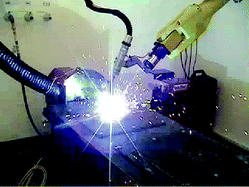Hexavalent chromium content in stainless steel welding fumes is dependent on the welding process and shield gas type†
Abstract
Occupational exposure to welding fumes is a known health hazard. To isolate elements in stainless steel welding fumes with high potential for adverse health outcomes, fumes were generated using a robotic gas metal arc system, using four shield gases of varying oxygen content. The objective was to measure CrVI concentrations in a broad spectrum of gas metal arc welding processes, and identify processes of exceptionally high or low CrVI content. The gases used were 95% Ar/5% O2, 98% Ar/2% O2, 95% Ar/5%CO2, and 75% He/25% Ar. The welder was operated in axial spray mode (Ar/O2, Ar/CO2), short-circuit (SC) mode (Ar/CO2 low voltage and He/Ar), and pulsed axial-spray mode (98% Ar/2% O2). Results indicate large differences in CrVI in the fumes, with Ar/O2 (Pulsed) > Ar/O2 > Ar/CO2 > Ar/CO2 (SC) > He/Ar; values were 3000 ± 300, 2800 ± 85, 2600 ± 120, 1400 ± 190, and 320 ± 290 ppm respectively (means ± standard errors for 2 runs and 3 replicates per run). Respective rates of CrVI generation were 1.5, 3.2, 4.4, 1.3, and 0.46 µg/min; generation rates were also calculated in terms of µg CrVI per metre of wire used. The generation rates of CrVI increased with increasing O3 concentrations. Particle size measurements indicated similar distributions, but somewhat higher >0.6 µm fractions for the short-circuit mode samples. Fumes were also sampled into 2 selected size ranges, a microspatter fraction (≥0.6 µm) and a fine (<0.6 µm) fraction; analysis indicated that CrVI is primarily associated with particles <0.6 µm. The conclusion of the study is that CrVI concentrations vary significantly with welding type and shield gas type, and this presents an opportunity to tailor welding practices to lessen CrVI exposures in workplaces by selecting low CrVI-generating processes. Short-circuit processes generated less CrVI than axial-spray methods, and inert gas shielding gave lower CrVI content than shielding with active gases. A short circuit He/Ar shielded process and a pulsed axial spray Ar/O2 process were both identified as having substantially lower CrVI generation rates per unit of wire used relative to the other processes studied.


 Please wait while we load your content...
Please wait while we load your content...